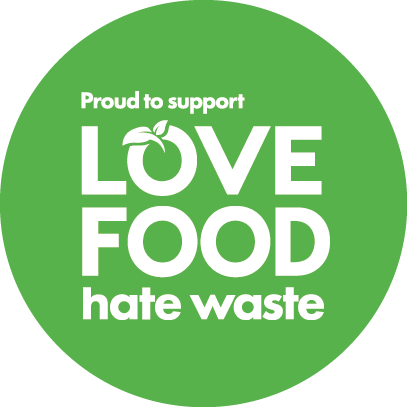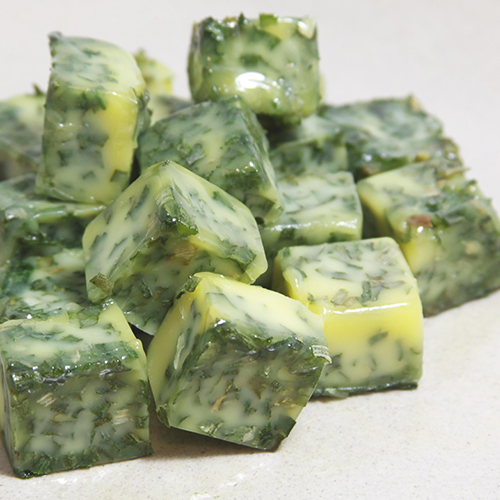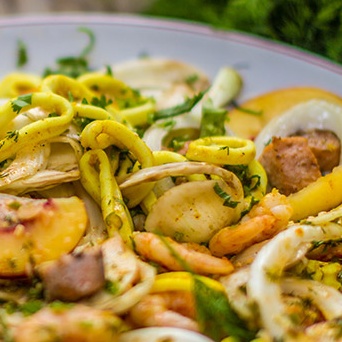This is a concept which simply means to completely eat the whole food. Yes that’s the whole thing! This was a concept which was common place in war time years when food was scarce and in many homes across the world. I grew up in a home where you didn’t waste anything and you certainly didn’t waste food! Throwing food away is considered a sin in the Indian culture, because food is a necessity and it’s to be respected.
Times have moved on and sadly the years of re-inventing leftovers, being creative in the kitchen very rarely apply. We throw out what we don’t want, it has become normal to waste huge amounts of food either because we don’t know how to make the most of all the parts of the ingredient or because of personal preference. Lack of education about cooking and buying effectively are probably to blame too but having everything is at our fingertips in this digital age, we simply and easily replace with new ingredients. It has become the norm to refine our diet and unfortunately this has resulted in losing nutrients which we can easily access by eating all our food. Personal preference of whether to leave the skin on potatoes, eat the crusts on our sandwiches plays a big part in food waste. To combat the impact this is having on our environment we need to start #compleating!
These are some inventive and exciting things you can do to reduce waste in your home, eat better, be more efficient in the kitchen and save money. Using your freezer effectively is a great way to make the most of your time, money and energy when it comes to cooking great food and storing left overs at home. There are so many little things we can do so here are some little tips and tricks to help you reduce waste. Top tricks for compleating!
1. Potatoes
We throw away 710,000 tonnes of potatoes each year! You may think you don’t like potato skins but they add texture and an amazing flavour, plus it saves you a peeling job! Just scrub your potatoes and cook them with the skins on. From spiced potato wedges, chips with skins on to the good old baked potato the skin is where the goodness and fibre is and as a nation we are consuming well under the commended value of fibre we should be. Not only will it fill you up better, its nutritionally better and easier in the kitchen! If you are going to peel them then save the peelings and you can top with spices smear them with minced lamb and cover in cheese and bake them to make loaded potatoes skins.

2. Bread
On average a staggering 19 loaves of bread per household are thrown out in the UK. Bread and even stale bread is so usable in many different ways. There are now companies such as Crumbs Brewery that are using stale bread to make beer!
One idea is to blitz left over bread and crusts in a blender and put the crumbs into a freezer bag and freeze. You can then use these as breadcrumbs to coat chicken, top your cauliflower cheese or shepherds pie.
Freeze what you can’t use straight away and use it to make toast in the morning.
Stale bread is perfect for making croutons with, flavour with garlic and herbs and have then with soup or top with smashed avocado. Puddings are also a great way to use up old bread too.
3. Broccoli and Cauliflower
We are all about increasing our vegetable intake but that doesn’t just mean eatting the pretty bits! Did you know that you can use the stalks from broccoli and cauliflower in your dishes too. The stalks have a great texture and it seems crazy to throw them away. I even use the tender leaves too, just chop them up and add to your dish. This is how I do in in my Aloo Gobi recipe. You can also shave the stalks into salads or use them to make coleslaw. Try simply sautéing them with some cumin and mustard seeds for a spin on Bombay aloo with your curry.
4. Ginger
I never peel my ginger, I wash it and grate it with the skin on. It adds texture and you don’t lose the juice from it. If you do want to peel it, keep the peel and add it to your tea to make and Indian chai infusion. It’s full of anti-oxidants and tastes great especially if you have the sniffles. You can pop the peel in the freezer until you need it. On another point when using delicate herbs such as coriander, basil etc use all the plant – not just the leaves, the stalks are full of aromatic and fragrance so chop them up finely. You can even use the roots of some herbs too.
5. Vegetable Peelings
There are just rubbish right? WRONG they are edible and for many vegetables the goodness sits just under the skin so why would we want to throw it away? Here are a few things you can do with your peelings that are more imaginative then putting them into you food waste bin.
Stocks and sauces - Fry in a little oil with onions and garlic and add water and simmer to make a stock. I throw in all the left over bits from my onion and garlic too, the onion peel gives the stock a great colour. If you have bones and meat left over you can add these too. Simmer for as long as you can, sieve and you can freeze this stock until you need it. It can be used to make gravy, risotto and soup and loads more.
Crisps - Toss the peelings of root vegetables (potatoes, carrots, parsnips) into a little oil season with salt and pepper and place on an oven tray and bake at 200C for about 8-10 minutes. You can use these to snack on, be cheffy and use them to add texture to your dishes or even use as toppings to pies. You can add chilli and other spices to liven them up as well!
Pakora - Veg peelings can be spiced up using cumin, chilli, salt, fresh coriander, ginger, garam masala and mixed with some gram flour. Add a little water to make a thick batter and deep fry to make some delicious vegetable peeling pakora.
6. Seeds
Vegetable and fruit like pumpkin and melon are full of seeds that are just thrown away. Did you know they have huge nutritional value and are packed with vitamins and minerals? Consumers spend a fortune on buys seeds from health food shops surely making your own is more sensible? Just wash them, dry them and roast them with a little oil and flavour them with salt and spices or sugar and cinnamon to make the most amazing toppings for your breakfast oats, soups and salads. Here is my Spiced Pumpkin Seed recipe.
7. Pickling and Fermenting
You can pickle anything (apples, carrots, onions, cucumber etc) and it’s a great to have these in the fridge for salads and snacks. Pickling is so simple to do all you need are equal parts water and vinegar and a quarter sugar to salt and then you can add any spices you fancy. Boil the liquid with the salt, sugar and spices, simmer for 10 minutes. Pour the hot brine over your pickling ingredients into a jar and leave to cool, seal and chill until needed.

Fermenting to make flavoured vinegars is all the rage at the moment, you can use them to dress salads, flavour soups with or use them to drip bread into to snack on. Making your own flavoured vinegar is fun and you can use any leftover fruit from apple cores and peel to pineapple rind. Simply, mix your fruit leftovers with sugar and submerge the fruit with water in a wide mouthed jar. Cover with a tight fitting cloth lid so the Carbon Dioxide, which is released when bacteria ferment the fruit can escape – we don’t want any explosions. Stir the mixture every day and after a few days it will start to ferment and bubble and release a slight alcoholic aroma. Naturally occurring bacteria will convert the alcohol to vinegar and after a week or so it will start to taste sour. Once the bubbling has stopped stain the fruit out and save the flavoured vinegar to use in your kitchen.
8. Citrus Peelings
These are a great for flavouring water, oil, vinegar, honey, liquor or using in baking. You can just peel and add them to you water etc or you can dehydrate them to make a fine powder as a flavouring. All you do is boil the peelings and cook for a few minutes. Rinse in cold water – repeat this process once more then lay the peelings on a rack over a baking sheet and dry in the oven at about 60C for 18-24 hours. Alternatively you can use a dehydrator. Once they are dry and brittle blitz to a powder in a spice grinder and store in a jar.
9. Vanilla Pods
Once you have scraped the seeds out of your vanilla pods don’t throw the outer pod away. Put them into a pot of sugar and before you know it you will have vanilla infused sugar that you can use to make cakes – simples.
10. Fruit Skins
Yes we throw these away but did you know that you can eat them? Don’t bother peeling your kiwis you can eat the skin. Others can be cooked for this curry you can use Banana skin or even melon rind!
Banana Skin Curry
Prep time: 40 mins, Cook time: 20 mins, Total cooking time: 1 hour
Serves: 4 People
Ingredients
- The skins of 6 large bananas, washed and soaked in a bowl of water with ¼ tsp turmeric
- 2 tsp cumin seeds 1 tsp coriander seeds
- 4 cloves garlic, peeled and minced
- 7cm piece root ginger, peeled and grated
- 1 tsp salt, or to taste
- ½ tsp turmeric
- 1 tbsp coconut oil
- 1 tsp black mustard seeds
- 1 tsp kalonji seeds
- 1 large onion, diced
- 15 curry leaves
- 1 or 2 fresh red chillies, chopped
- 4 tbsp fresh coconut, shredded
- A squeeze of lime juice
- Large pinch fresh coriander, chopped
Method
- Wash your banana skins and remove any hard woody stalks.
- In a bowl of water add about ¼ tsp of turmeric. Place the skins in the bowl for about half an hour so they don’t go brown and start to soften.
- In a pestle and mortar grind your coriander and cumin seeds and set to one side. Dice the onion, chop the garlic and grate the ginger and set to one side.
- Remove the skins from the turmeric water and chop the skins into bit size chunks.
- Heat the coconut oil in a pan and add the mustard and kalongi seeds. Once the spices pop add the chopped onion.
- Cook until the onions turn golden add the garlic, ginger and curry leaves stir for another minute.
- Add the ground spices, turmeric, salt and chopped chilli with a splash of water so the spices don’t burn.
- Sauté for 1 or 2 minutes and add your banana peels and coconut. Add about 2-3 tbsp of water and reduce to a low heat.
- Cook until the banana peels are tender. If you want a bit of a sauce you can add a little water too.
To serve: Squeeze over a little lime juice and top with fresh coriander.
For more information about competeling visit the Love Food Hate Waste website.
Back to Blog



Steve Wilcox
reply